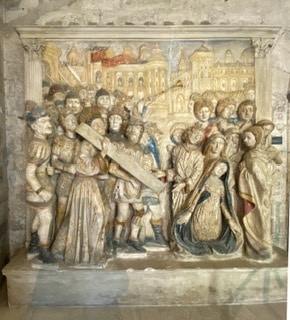In Avignon, Judy and I chose different morning excursions. The decision was a difficult one since Avignon offered so many interesting things to see.
I chose the walking tour of the city which included the Papal Palace. When I was in seminary the move of the pope to Avignon was an interesting part of our church history class. I wanted to see the site where the papacy had moved from Italy to France.




In the 1300’s, the French KIng, Phillip IV was very powerful. When a conflict arose between the king and the papacy, Philip forced the enclave to elect a French Pope, Clement V. When Clement refused to move to Rome, the Papal residence was relocated from Rome to Avignon. Seven successive popes lived here from 1309 until 1377 when Gregory XI moved his court back to Rome.




The elaborate buildings of the pope still exist in Avignon and the tour described their excessive lifestyle. The pope, particularly in those days, lived like a king. In the Middle Ages, the first born son of a king was to rule in his succession. Often the second born son was sent to enter the priesthood in the hopes that he would be elected pope, thus strengthening the power of the throne in his home country. These second born sons had grown up in palaces and if elected to the papacy, expected to live with all the regal surroundings that their brother enjoyed at home.



The papal palace was beautifully decorated along the wall and ceilings with beautiful art as seen in the pictures that accompany this blog. They ate extremely well; the banquet hall of the pope not unlike the banquet hall of any king in that time. The pope’s bother may have ruled a kingdom, but the pope ruled over the religious life of the church.

Judy on the other hand, preferred the famous Pont du Gard. Her group took a thirty minute drive through the countryside filled with vineyards (Cote du Rhône wine translated is “side of the Rhone”) before arriving to the amazing aqueduct that took ten to fifteen years to complete, but was used for five centuries. The site was named in 1985 as one of only 4 UNESCO World Heritage sites in France. From bottom to top equal to the height of the Statue of Liberty and as long as the wing span of a passenger jet. It was build in the first century A.D. to carry water thirty-one miles to Nimes. It crosses the Gardon River, source in the nearby mountains. It is the highest of all Roman aqueduct bridges and one of the best preserved in all the world. It carried water to Nimes to be used in fountains, baths and homes. Lack of maintenance in the fourth century led to the clogging of mineral deposits and debris that eventually stopped the flow of water.

The aqueduct bridge became a tourist destination in the eighteenth century and has undergone a series of renovations between the eighteenth and twenty-first centuries. A tourist center with a museum, cinema for depicting information about the aqueduct, and shops opened in 2000. Today it is one of France’s most popular attractions.

After taking panorama shots Judy huffed up to the top. The original tunnel flow entrance is still there. Taking a picture from that point up top was blocked off today, but they were able to walk across the lower tier.

The stone blocks , some weighing as much as six tons were precisely cut, fitting together by friction alone eliminating the need for mortar. The huge structure was built with slave labor. It has survived three serious floods over the last century. In 1958 the entire lower tier was submerged; also flooded in 1998 and 2002.

It surpassed anything Judy expected and she was so glad she chose to do this. It took lots of walking—she found that it helps the back to keep moving. We both have found that stopping and standing does havoc to our backs.

It is the highest of all the Roman aqueduct bridges and is considered an engineering marvel.
While Charles took a bike ride Judy walked into the walled ivy to get more pictures and window shop. It seemed to be a typical Saturday—very crowded with tourists and locals alike just enjoying a warm day.




Leave a Reply